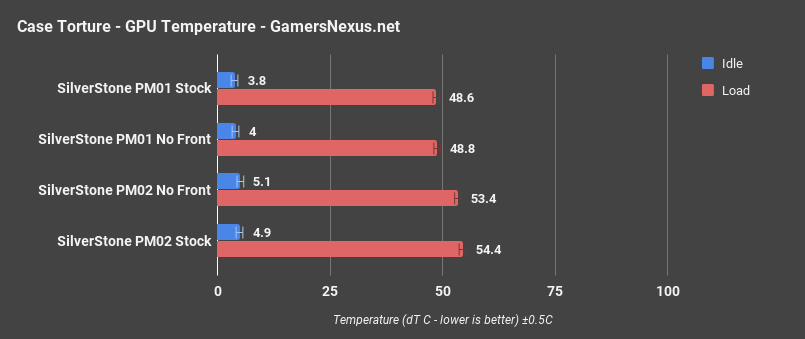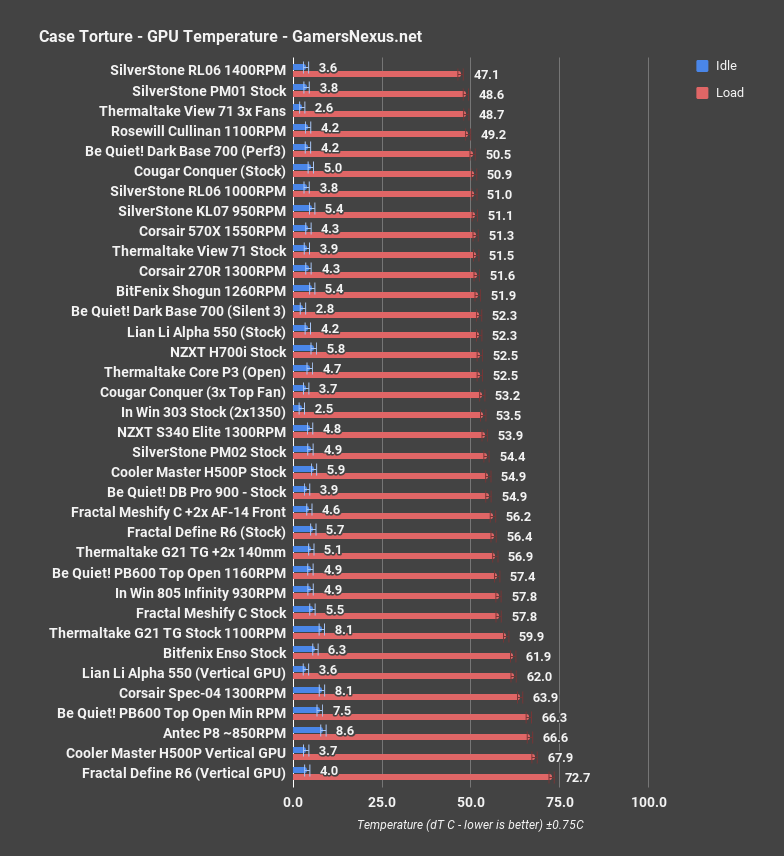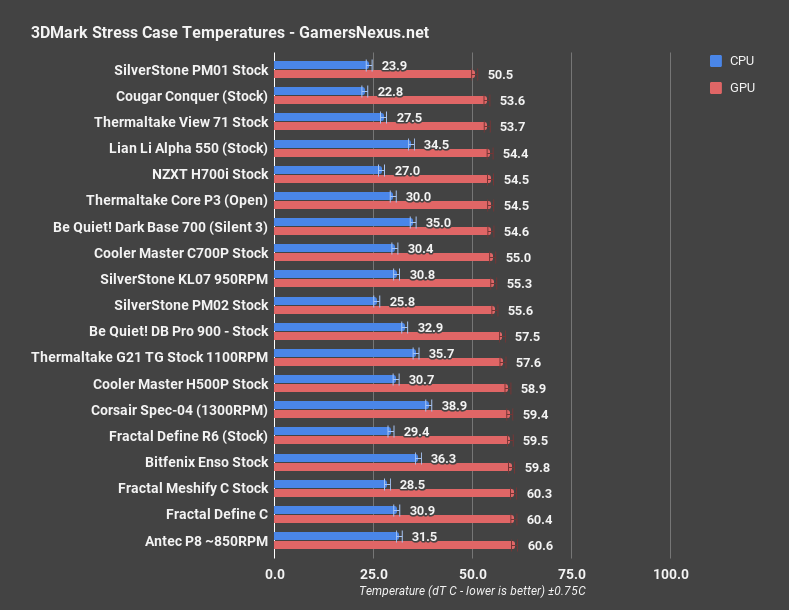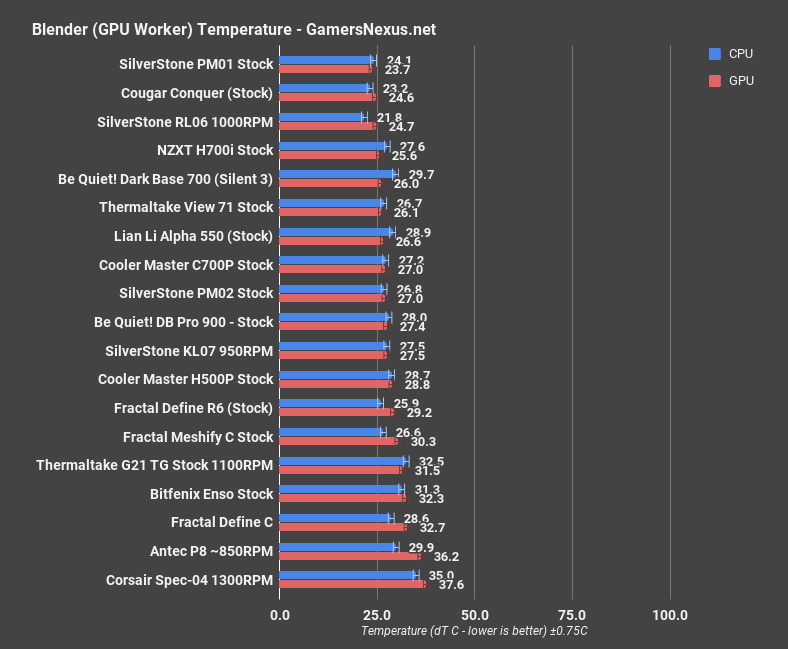The PM02 is the successor to Silverstone’s Primera 01, a case we’ve often referenced but have never fully reviewed. As Silverstone points out on their site, Primera is Spanish for “first,” so please take a quiet moment to appreciate the name “Primera 02.” This (still) isn’t a review of the PM01, but since it will continue to be sold alongside the PM02 (~$140), we took this opportunity to do some testing and make a close comparison. The original Primera should be a familiar sight to anyone that’s seen our render rig or the community-funded gift PC from a few months ago. Because the two cases seen in those videos are being used, we acquired yet another for this article--we like the 01 a lot.
This review will benchmark the SilverStone PM01 vs. the PM02 and RL06 airflow PCs, with additional testing conducted across other popular on-market cases, including the H500P.
SilverStone PM02 Specs
Model | PM01 | PM02 |
Material | Plastic outer shell, steel body, tempered glass side panel | Steel front panel, steel body, tempered glass window |
Motherboard | ATX (up to 12" x 10.7"), Micro-ATX | ATX ( up to 12" x 11") , Micro-ATX |
Drive Bays | 2.5" or 3.5" x 4, 2.5" x 5 | 3.5" x 3 (compatible with 2.5") , 2.5" x 3 |
Cooling system | Front: 3 x 120mm / 140mm fan slot (includes 3 x 140mm fan + RGB LED fan guards) | 3 x 120 / 140mm fan slot (includes 3 x 140mm PWM fan) |
Rear: 1 x 120mm / 140mm fan slot (includes 1 x 140mm fan) | 1 x 120mm / 140mm fan slot (includes 1 x 140mm PWM fan) | |
Top: 3 x 120mm fan slot or 2 x 140mm fan slot | 2 x 120mm / 140mm fan slot | |
Radiator support | Front: 2 x 120mm ; 1 x 240mm / 280mm / 360mm | 1 x 120mm ; 1 x 240mm / 280mm / 360mm |
Rear: 1 x 120mm / 140mm fan slot (includes 1 x 140mm fan) | 1 x 120mm / 140mm | |
Top: 2 x 120mm ; 1 x 240mm / 280mm / 360mm | 2 x 120mm ; 1 x 240mm / 280mm | |
Expansion slot | 7 | 7 |
Front I/O port | USB 2.0 x 2 USB 3.0 x 2 Audio x 1 MIC x 1 | USB 3.0 Type-A x 3, USB 3.1 Gen1 Type-C x 1 Audio x 1 MIC x 1 |
Power supply | Standard PS2(ATX) | Optional PS2(ATX) |
Expansion card | Support graphics card up to 16.5" (419mm), width restriction - 6.88" (174mm) | Compatible up to 16.3" (415mm) in length, width restriction –6.85" (174mm) |
Limitation of CPU cooler | 180mm | 167mm |
Limitation of PSU | 240mm | 190mm |
Net weight | 10.1kg | 8.82 kg |
Dimension | 220mm (W) x 571mm (H) x 560mm (D), 70.3 Liters 8.66" (W) x 22.48" (H) x 22.05" (D), 70.3 Liters | 220mm (W) x 491mm (H) x 456mm (D), 49.3 Liters 8.66" (W) x 19.33" (H) x 17.95" (D), 49.3 Liters |
Extra | Built-in RGB LED controller |
SilverStone PM02 Appearance
Appearance-wise, the PM02 has almost nothing in common with the PM01. The most obvious and alarming difference is the elimination of the mesh front panel, which is most of why we liked the PM01. The large front and top panels are gone, replaced by a perforated steel sheet and a magnetic mesh filter respectively. Silverstone describes the Primera line as “Pioneering computer case[s] with exceptional style and functionality,” so the connecting theme seems to be that they’re some of Silverstone’s nicer cases that don’t fit into the Raven series.
Depending on your opinion of mesh grates, the 01 looks either a little old fashioned or cutting-edge: this is one instance where lagging behind current case trends put Silverstone ahead of their competitors. The version we tested this time is a PM01-RGB, which comes with a glass side panel and RGB LEDs, but is functionally identical to the base model. It’s huge, with deep top and front panels that sculpt the profile of the case in the style of old full towers like the Thor V2 or NZXT Phantom. This is in contrast to the 02, which is a smaller and more stripped-down design with a flat front panel and no removable top panel. It’s modern, but that doesn’t necessarily translate to “good” here: there’s no mesh grate on the 02, although there is some limited perforation of the steel panel. We’ll cover this more in the thermal section.
SilverStone PM02 Build
Building in the PM01 was already fairly easy, thanks to the large interior, but there are some improvements made in the PM02. The glass side panel uses two old-fashioned thumbscrews together with metal hooks at the bottom that fit into the chassis, a simple but superior alternative to the 01’s four thumbscrews. Both use protective rubber washers that wedge into the glass, which is a minor detail but prevents them from falling out and rolling away as they tend to do on other cases. The 02’s other side panel is unexciting, but it differs from the PM01’s in an important way: every single time we build in a PM01, it’s practically impossible to pry the metal side panel off. The PM01 also has an optional flaming unicorn graphic on the metal panel, but whether that’s good or not is subjective. There isn’t really a removable top panel in the 02 other than a magnetic filter, but that’s probably for the best--Silverstone really went overboard with the number of screws in the 01, and it makes it a hassle to top-mount fans and radiators.
Ignoring airflow concerns for the moment, 02’s front panel is great. It’s made of thick, heavy steel and plastic and it doesn’t flex at all when it’s pried off. The fasteners are ball-and-cup snaps, the kind that hold the side panels of the Define R6 on, which makes it easy to remove and clean the filter without breaking clips. It’d be nice to have a way to clean it without taking off the front panel at all, but at least it’s easy. There’s an LED hidden behind the front which projects the Silverstone logo onto the surface below, which works well and is removable.
There are three 3.5” bay locations in the PM02, which is one more than a lot of modern cases, but one less than the 01. That’s not a concern for the typical user, but as a case that we personally use for business, it’s the only area where the 01 falls short of our usual preferences. The drive cage is pushed to the extreme forward end of both cases, but the 01’s overall size allows for significantly longer PSUs--or in this case, larger wads of loose cables. The toolless 2.5” bays swing out like cassette decks in the 02 as they did in the KL07, and front I/O includes three USB 3.0 and one USB C port.
Case Testing Methodology
We tested using our new Skylake case test bench, detailed in the table below. This particular configuration is brand new with the launch of the 570X & 270R. Results on this test platform cannot be compared to previous case benchmark results, as the platform has completely changed.
Conducting thermal tests requires careful measurement of temperatures in the surrounding environment. We control for ambient by constantly measuring temperatures with thermocouples and laser readers. We then produce charts using a Delta T(emperature) over Ambient value. This value subtracts the thermo-logged ambient value from the measured diode temperatures, producing a delta report of thermals. AIDA64 is used for logging thermals of silicon components, including the GPU diode.
All case fans are manually configured to their maximum throughput using BIOS, then we configure to an RPM closer to 1050 for a universal "quiet" testing. If a fan controller is present, we opt-in and test on multiple settings. This forces testing of case fan performance in addition to the case's air channeling and airstream design. This also ensures minimal variance when testing, as automatically controlled fan speeds can reduce reliability of benchmarking. The CPU fan is set to 1100RPM (constant) for consistency, and the CPU is overclocked to 4.4GHz with a vCore of 1.272V (constant). C-States and power saving states are disabled.
| Component | Courtesy Of | Price | |
| Video Card | MSI GTX 1080 Gaming X (OC Mode) | MSI | $640 |
| CPU | Intel i7-6700K @ 4.4GHz | GamersNexus | $300 |
| CPU Cooler | MSI Core Frozr L | MSI | TBD |
| Motherboard | MSI Z170A Gaming M7 | MSI | $180 |
| Memory | Corsair Vengeance LED 32GB 3200MHz | Corsair | $200 |
| SSD | Samsung 850 EVO 120GB | Samsung | N/A |
| PSU | Corsair RM650x | Corsair | $100 |
| Case | This is what we're testing! | - | - |
The video card is configured to run at 55% fan speed at all times.
Prior to load testing, we collect idle temperature results for ten minutes to determine the unloaded cooling performance of a case's fans and air channels. Thermal benchmarking is conducted for 1400 seconds (23 minutes), a period we've determined sufficient for achieving equilibrium. The over-time data is aggregated and will occasionally be compiled into charts, if interesting or relevant. The equilibrium performance is averaged to create the below charts.
Load testing is conducted using Prime95 LFFTs and Kombustor “FurMark” stress testing simultaneously. Testing is completely automated using in-house scripting, and executes with perfect accuracy on every run.
We recently validated our test methodology using a thermal chamber, finding our approach to be nearly perfectly accurate. Learn more here.
Thermals & Noise
The PM02 takes the same four-fan-brute-force approach to cooling that the PM01 and RL06 did, 3 intake and 1 exhaust, but without the mesh panel. We have plenty (too many) cases, and the reason we chose the Primera 01 for multiple builds was the mesh front--we can add fans, but adding mesh is harder. If the 02 can’t cool as well as previous Silverstone enclosures, there’s little to separate it from dozens of similar tempered glass cases. We didn’t bother testing any additional fan configurations this time since four slots were already populated, but we did remove the front panel to test the level of airflow obstruction.
SilverStone PM02 CPU Torture vs. PM01
We’re starting our charts with a strict comparison between the PM01 and PM02. The Primera 01 kept CPU dT at 3C idle and 48.6C under a Prime95/Furmark torture workload, while the PM02 idled at 3.7C dT and averaged 54.1C dT under load. The closed-off front panel of the 02 is the obvious culprit for higher temps, but it’s possible that the top panel of the 01 is more breathable as well since the huge plastic cover eliminates the need for a dust filter. Removing the front panel of the 01 had no effect whatsoever on CPU temps, whereas removing the 02’s front panel lowered CPU dT to 48.9C, almost exactly what the stock 01 scored. This is the difference of a front panel. A 5-degree drop isn’t the biggest we’ve gotten by removing a front panel, so the 02’s isn’t blocking a huge amount of air, but it’s notable here because it indicates that the PM02 could perform just as well as the PM01 if it received the same mesh treatment. To reiterate: This doesn’t mean the PM02 is bad relative to most other cases, or even in a vacuum; that said, it is disappointing that the PM02 loses the spirit of the PM01, and it’s all to meet modern industry trends.
SilverStone PM02 CPU Torture vs. All
Moving to a comparative chart, 54.1C is pretty good compared to the rest of our chart, at the level of respected cases like the stock Meshify C or H700i; however, those cases didn’t have the advantage of four 140mm fans running at full blast, and they also didn’t have predecessors with a particular reputation for high airflow. The PM01’s CPU temperature of 48.6C puts it among our top performers, alongside the open-air Cougar Conquer and just slightly warmer than its smaller sibling the RL06, also near the Meshify C kitted-out with Noctua AF-14s. That’s the context that the PM02 is fighting here, and in that context, it is uninteresting. SilverStone’s Primera series has fallen from a chart-leader to something that sits above average. That’s still above average, mind you, and it’s still in the top quarter of the pack. Temperatures are doing just fine. It is in the context of predecessors that we look at iterations on design, though, and the context set a high bar to beat. The PM02’s CPU cooling is a disappointing step down.
SilverStone GPU Torture PM01 vs. PM02
GPU temps were 3.8C dT idle and 48.6C dT under load in the 01, and 4.9C idle and 54.4C under load in the 02. The perforations in the PM02’s front panel thin out towards the bottom, mostly below the level of the PSU shroud, but this could restrict airflow at the bottom of the case. Unlike some other cases, there’s no big air vent at the bottom of the front panel, since that’s where the transparent Silverstone logo is placed to be projected onto the desk. As with CPU temperatures, taking the front panel off of the 01 had no effect on GPU temps, but taking the panel off the 02 also had little effect. There’s also the LED projector mounted in front of the bottom fan, which provides another minor obstruction.
SilverStone PM02 GPU Torture vs. All
Again, the PM01 performed spectacularly, outperforming most cases other than the RL06. There’s not any secret to why these two cases perform so well: they have a lot of mesh and a lot of fans. The 02’s performance was more average, near the H500P. GPU boosting is adjusted with heavy workloads to keep temperatures down (we usually use “throttling” as a catch-all term for clock limitations like this), so check the Blender section for a lower intensity benchmark.
SilverStone PM02 3DMark
The RL06 isn’t on our 3DMark comparative chart, so at 50.5C GPU dT the PM01 is easily the coolest of what we’ve tested. 55.6C dT for the 02 places it at the middle of the chart, just above Silverstone’s own KL07. Again, the 02’s performance here would be fine if it wasn’t following up one of the best-performing cases we’ve tested.
SilverStone PM02 Blender
Rendering on the CPU, CPU dT averaged 36.7C in the PM01 and 39.2C in the PM02. The 01 places between the Cougar Conquer and Define R6, while the 02 is again stuck in the middle with the H500P.
Rendering on the GPU, GPU dT averaged 23.7C in the PM01 and 27C in the PM02. This test eliminates the boost concerns of the more stressful 3DMark and Furmark workloads, proving that there really is better GPU cooling in the 01. 27C is the same as the Cooler Master C700P and between the Alpha 550 and Dark Base Pro 900, cases that we liked for reasons other than airflow.
SilverStone PM02 Noise
Predictably, the PM01 and PM02 are respectively the noisiest and second noisiest cases we’ve ever tested by a decent margin, and that includes the RL06. The PM02 does have more sound dampening thanks to the closed front panel, but not nearly enough to make an audible difference. The noise levels are taken when running the fans at max RPM and any fan curve should reduce noise significantly, but there are a lot of fans in each case and not much material separating them from the user.
SilverStone PM02 Conclusion
The PM02 is a fine case, perhaps even above average in performance when many companies are still churning out sealed front panels with only one or two 120mm fans. In isolation, $140 is an acceptable value for four preinstalled fans and a tempered glass side panel, but the market is overflowing with similar cases, from the Thermaltake Core G21 to the TG version of Silverstone’s own RL06.
The elephant in the room is the PM01, which was and is a great case that we’ve enjoyed using. In some respects it’s not fair to treat the 02 as a successor to the 01, because they’re dissimilar enough to be from completely different product lines. If it is a successor, the PM02 fails to fill the PM01’s shoes. The 01 just performs better. There aren’t even any shoes to fill, because the PM01 is still being sold. At the same price, we’d prefer the PM01, but the original plastic-windowed PM01 is actually cheaper at $120-ish on Amazon.
Silverstone seems to have fallen into a pattern here. We’ve mentioned the Redline 06 throughout this article as another excellently cooled case, but as we saw at Computex, the RL07 and RL08 are chasing the sealed front panel trend. We hope that in the future Silverstone will try to preserve the positive aspects of well-received cases, or at least not present worse-performing cases as the next iterations of better ones.
Editorial, Testing: Patrick Lathan
Host, Test Lead: Steve Burke
Video: Andrew Coleman







